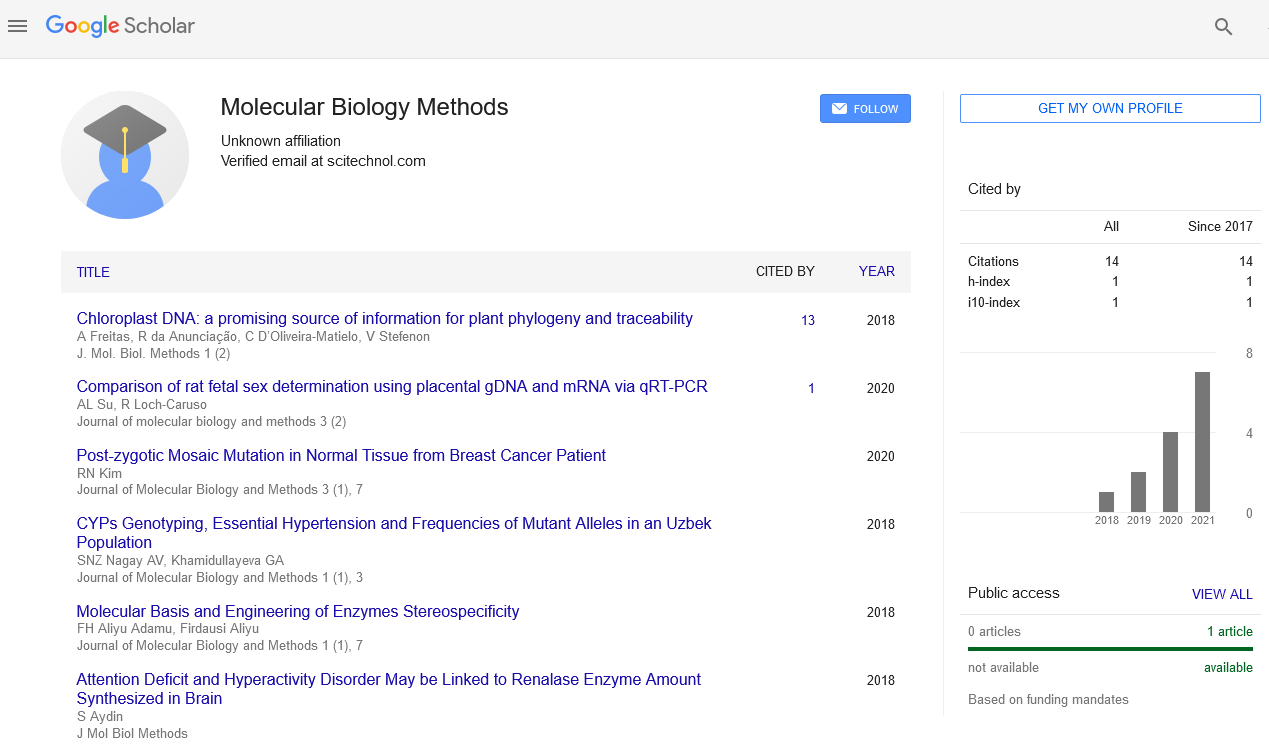Commentary, J Mol Biol Methods Vol: 7 Issue: 1
Microarray Technology: A Detailed Study
Jenny Martinez*
1Department of Biology, Gonzaga University, Spokane, Washington, United States of America
*Corresponding Author: Jenny Martinez,
Department of Biology, Gonzaga
University, Spokane, Washington, United States of America
E-mail: martinezjenny@ac.edu
Received date: 26 February, 2024, Manuscript No. JMBM-24-136921;
Editor assigned date: 29 February, 2024, PreQC No. JMBM-24-136921 (PQ);
Reviewed date: 14 March, 2024, QC No. JMBM-24-136921;
Revised date: 21 March, 2024, Manuscript No. JMBM-24-136921 (R);
Published date: 28 March, 2024, DOI: 10.4172/JMBM.1000151
Citation: Martinez J (2024) Microarray Technology: A Comprehensive Overview. J Mol Biol Methods 7:1.
Description
Microarray technology has revolutionized the field of molecular biology by allowing researchers to simultaneously analyze the expression levels of thousands of genes or detect variations in DNA sequences. This powerful tool has applications across various disciplines, including genomics, transcriptomics, epigenetics, and clinical diagnostics. In this comprehensive overview, we will delve into the principles, types, applications, and future prospects of microarray technology.
At its core, a microarray is a miniature platform containing thousands to millions of microscopic spots, each immobilized with specific nucleic acid probes. These probes can be either DNA fragments, complementary to known genes or DNA sequences, or oligonucleotides, short synthetic DNA sequences. The microarray platform enables high-throughput analysis of nucleic acid samples by hybridizing them with the probes immobilized on the surface.
The hybridization process occurs when single-stranded DNA or RNA molecules from the sample bind to their complementary sequences on the microarray. After hybridization, the microarray is scanned to detect the fluorescent signals emitted by the bound molecules. The intensity of these signals corresponds to the abundance of the target sequences in the sample.
Types of microarrays
DNA microarrays: These microarrays contain immobilized DNA probes and are used to detect variations in DNA sequences, such as Single Nucleotide Polymorphisms (SNPs), Copy Number Variations (CNVs), or mutations. DNA microarrays are widely employed in genetic research, pharmacogenomics, and forensic analysis.
RNA microarrays: RNA microarrays contain probes complementary to mRNA transcripts and are used to measure gene expression levels across different experimental conditions or biological samples. They enable researchers to study gene regulation, identify biomarkers, and characterize disease mechanisms.
Applications of microarray technology
Microarray technology has diverse applications in various fields of biology and medicine. Some of the key applications include:
Gene expression profiling: RNA microarrays are extensively used to measure the expression levels of thousands of genes simultaneously. This enables researchers to identify genes that are differentially expressed under different conditions, such as disease states or drug treatments.
Genotyping and SNP analysis: DNA microarrays are employed for genotyping studies to detect variations in DNA sequences among individuals. SNP microarrays are particularly useful for association studies to identify genetic variants associated with diseases or traits.
Cancer research: Microarrays play a crucial role in cancer research by enabling the characterization of gene expression patterns in different cancer types. This information can be used for cancer classification, prognosis prediction, and identification of potential therapeutic targets.
Challenges and future prospects
Despite its widespread use and significant contributions to biological research, microarray technology is not without limitations. One of the main challenges is data analysis and interpretation, particularly handling large datasets generated from microarray experiments. Additionally, microarray technology has been largely supplanted by Next-Generation Sequencing (NGS) techniques in many applications due to NGS's higher throughput, lower cost per base, and ability to provide information on DNA sequences, RNA expression, and epigenetic modifications simultaneously.
However, microarrays still offer certain advantages over NGS, such as lower upfront costs, simpler experimental procedures, and compatibility with small sample sizes. Furthermore, advancements in microarray technology continue to improve its performance and versatility. For example, the development of high-density microarrays with increased spot densities and enhanced probe design has led to higher sensitivity and specificity in detecting nucleic acid targets.
 Spanish
Spanish  Chinese
Chinese  Russian
Russian  German
German  French
French  Japanese
Japanese  Portuguese
Portuguese  Hindi
Hindi 